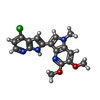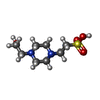[English] 日本語
 Yorodumi
Yorodumi- PDB-3lvp: Crystal structure of bisphosphorylated IGF1-R Kinase domain (2P) ... -
+ Open data
Open data
- Basic information
Basic information
| Entry | Database: PDB / ID: 3lvp | ||||||
|---|---|---|---|---|---|---|---|
| Title | Crystal structure of bisphosphorylated IGF1-R Kinase domain (2P) in complex with a bis-azaindole inhibitor | ||||||
 Components Components | Insulin-like growth factor 1 receptor | ||||||
 Keywords Keywords | TRANSFERASE / protein kinase / tyrosine kinase / tyrosine phosphorylation / protein-substrate complex | ||||||
| Function / homology |  Function and homology information Function and homology informationprotein kinase complex / insulin-like growth factor receptor activity / insulin-like growth factor binding / Signaling by Type 1 Insulin-like Growth Factor 1 Receptor (IGF1R) / protein transporter activity / IRS-related events triggered by IGF1R / transcytosis / insulin receptor complex / insulin-like growth factor I binding / positive regulation of protein-containing complex disassembly ...protein kinase complex / insulin-like growth factor receptor activity / insulin-like growth factor binding / Signaling by Type 1 Insulin-like Growth Factor 1 Receptor (IGF1R) / protein transporter activity / IRS-related events triggered by IGF1R / transcytosis / insulin receptor complex / insulin-like growth factor I binding / positive regulation of protein-containing complex disassembly / insulin receptor activity / alphav-beta3 integrin-IGF-1-IGF1R complex / regulation of JNK cascade / dendritic spine maintenance / peptidyl-tyrosine autophosphorylation / insulin binding / amyloid-beta clearance / Respiratory syncytial virus (RSV) attachment and entry / insulin receptor substrate binding / SHC-related events triggered by IGF1R / phosphatidylinositol 3-kinase binding / negative regulation of MAPK cascade / insulin-like growth factor receptor signaling pathway / insulin receptor binding / cellular response to glucose stimulus / phosphatidylinositol 3-kinase/protein kinase B signal transduction / receptor protein-tyrosine kinase / cellular response to amyloid-beta / insulin receptor signaling pathway / positive regulation of cold-induced thermogenesis / protein autophosphorylation / protein tyrosine kinase activity / Extra-nuclear estrogen signaling / positive regulation of phosphatidylinositol 3-kinase/protein kinase B signal transduction / receptor complex / positive regulation of MAPK cascade / immune response / cilium / positive regulation of cell migration / axon / intracellular membrane-bounded organelle / positive regulation of cell population proliferation / negative regulation of apoptotic process / nucleolus / signal transduction / ATP binding / identical protein binding / membrane / plasma membrane Similarity search - Function | ||||||
| Biological species |  Homo sapiens (human) Homo sapiens (human) | ||||||
| Method |  X-RAY DIFFRACTION / X-RAY DIFFRACTION /  SYNCHROTRON / SYNCHROTRON /  MOLECULAR REPLACEMENT / Resolution: 3 Å MOLECULAR REPLACEMENT / Resolution: 3 Å | ||||||
 Authors Authors | Maignan, S. / Marquette, J.P. / Guilloteau, J.P. | ||||||
 Citation Citation |  Journal: Chem.Biol.Drug Des. / Year: 2010 Journal: Chem.Biol.Drug Des. / Year: 2010Title: Design of Potent IGF1-R Inhibitors Related to Bis-azaindoles Authors: Nemecek, C. / Metz, W.A. / Wentzler, S. / Ding, F.X. / Venot, C. / Souaille, C. / Dagallier, A. / Maignan, S. / Guilloteau, J.P. / Bernard, F. / Henry, A. / Grapinet, S. / Lesuisse, D. | ||||||
| History |
|
- Structure visualization
Structure visualization
| Structure viewer | Molecule:  Molmil Molmil Jmol/JSmol Jmol/JSmol |
|---|
- Downloads & links
Downloads & links
- Download
Download
| PDBx/mmCIF format |  3lvp.cif.gz 3lvp.cif.gz | 241.4 KB | Display |  PDBx/mmCIF format PDBx/mmCIF format |
|---|---|---|---|---|
| PDB format |  pdb3lvp.ent.gz pdb3lvp.ent.gz | 194.2 KB | Display |  PDB format PDB format |
| PDBx/mmJSON format |  3lvp.json.gz 3lvp.json.gz | Tree view |  PDBx/mmJSON format PDBx/mmJSON format | |
| Others |  Other downloads Other downloads |
-Validation report
| Summary document |  3lvp_validation.pdf.gz 3lvp_validation.pdf.gz | 1.4 MB | Display |  wwPDB validaton report wwPDB validaton report |
|---|---|---|---|---|
| Full document |  3lvp_full_validation.pdf.gz 3lvp_full_validation.pdf.gz | 1.5 MB | Display | |
| Data in XML |  3lvp_validation.xml.gz 3lvp_validation.xml.gz | 54.3 KB | Display | |
| Data in CIF |  3lvp_validation.cif.gz 3lvp_validation.cif.gz | 68.4 KB | Display | |
| Arichive directory |  https://data.pdbj.org/pub/pdb/validation_reports/lv/3lvp https://data.pdbj.org/pub/pdb/validation_reports/lv/3lvp ftp://data.pdbj.org/pub/pdb/validation_reports/lv/3lvp ftp://data.pdbj.org/pub/pdb/validation_reports/lv/3lvp | HTTPS FTP |
-Related structure data
| Related structure data |  1k3aS S: Starting model for refinement |
|---|---|
| Similar structure data |
- Links
Links
- Assembly
Assembly
| Deposited unit | 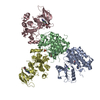
| ||||||||
|---|---|---|---|---|---|---|---|---|---|
| 1 | 
| ||||||||
| 2 | 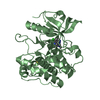
| ||||||||
| 3 | 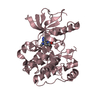
| ||||||||
| 4 | 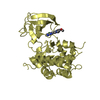
| ||||||||
| Unit cell |
|
- Components
Components
| #1: Protein | Mass: 38469.156 Da / Num. of mol.: 4 / Fragment: kinase domain (2P) Source method: isolated from a genetically manipulated source Source: (gene. exp.)  Homo sapiens (human) / Gene: IGF1R / Production host: Homo sapiens (human) / Gene: IGF1R / Production host:  References: UniProt: P08069, receptor protein-tyrosine kinase #2: Chemical | ChemComp-PDR / #3: Chemical | ChemComp-EPE / | #4: Chemical | #5: Water | ChemComp-HOH / | |
|---|
-Experimental details
-Experiment
| Experiment | Method:  X-RAY DIFFRACTION / Number of used crystals: 1 X-RAY DIFFRACTION / Number of used crystals: 1 |
|---|
- Sample preparation
Sample preparation
| Crystal | Density Matthews: 2.36 Å3/Da / Density % sol: 47.89 % |
|---|---|
| Crystal grow | Temperature: 292 K / Method: vapor diffusion, hanging drop / pH: 7.5 Details: 2.4M Ammonium Sulfate, 100mM Hepes, 5% glycerol, pH 7.5, VAPOR DIFFUSION, HANGING DROP, temperature 292K |
-Data collection
| Diffraction | Mean temperature: 100 K |
|---|---|
| Diffraction source | Source:  SYNCHROTRON / Site: SYNCHROTRON / Site:  ESRF ESRF  / Beamline: ID14-4 / Wavelength: 0.9 Å / Beamline: ID14-4 / Wavelength: 0.9 Å |
| Radiation | Protocol: SINGLE WAVELENGTH / Monochromatic (M) / Laue (L): M / Scattering type: x-ray |
| Radiation wavelength | Wavelength: 0.9 Å / Relative weight: 1 |
| Reflection | Resolution: 3→30 Å / Num. all: 30251 / Num. obs: 29918 / % possible obs: 98.9 % / Observed criterion σ(F): 2 / Observed criterion σ(I): 2 / Redundancy: 3.2 % / Rmerge(I) obs: 0.097 / Net I/σ(I): 5.9 |
- Processing
Processing
| Software |
| |||||||||||||||
|---|---|---|---|---|---|---|---|---|---|---|---|---|---|---|---|---|
| Refinement | Method to determine structure:  MOLECULAR REPLACEMENT MOLECULAR REPLACEMENTStarting model: 1K3A Resolution: 3→30 Å / σ(F): 2 / σ(I): 2
| |||||||||||||||
| Refinement step | Cycle: LAST / Resolution: 3→30 Å
|
 Movie
Movie Controller
Controller


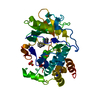
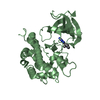
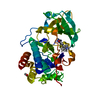


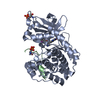
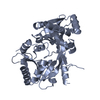
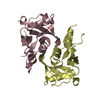
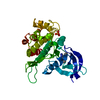

 PDBj
PDBj






